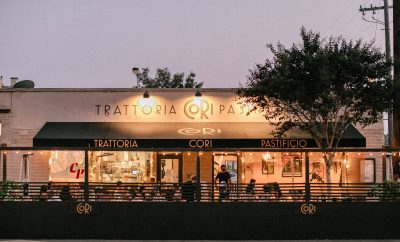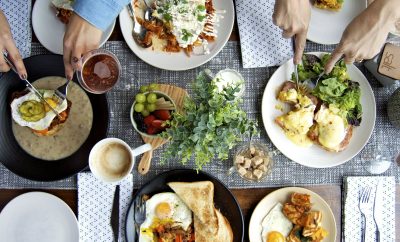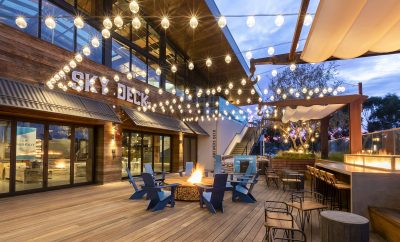Dining
Cent’Anni – Espresso Etiquette at Solana Beach’s “Caffe La Bocca”

The sidewalk cafés that line the piazzas and narrow streets of Rome, Venice, Milan and other Italian cities are quintessential romantic settings.
Italian cafés are places where you can see lovers kiss and friends laughing and divulging intimate secrets to one another. And since there are no paper cups in Italian café’s, you will hear the conspicuous sounds referred to as the “tintinnio” (Italian for clinking) of tiny stirring spoons on porcelain demitasse cups, complete with saucers.
Developed in Milan, Italy, in the early 20th century, espresso is a concentrated coffee beverage brewed by forcing hot water under pressure through finely ground coffee. Italians drink almost exclusively espresso coffee, and refer to other coffee as ‘acqua sporca’ (dirty water) meaning that the coffee in these drinks has no other effect than stain the water. Bars in Italy serve only espresso, and at home people use a stovetop espresso pot or an espresso machine.
A good cup of espresso offers an intoxicating aroma and coats the palate and taste buds for at least twenty minutes. Compared on the basis of usual serving sizes, a 1 fluid ounce shot of espresso has about half the caffeine of a standard 6 fluid ounce cup of American-style coffee, which varies from 80 to 130 mgs. The most distinguishing characteristic is the “crema,” reddish-brown foam that floats on the surface and is composed of vegetable oils, proteins and sugars. You know you have a good cup of espresso when you see the crema on top.
Born and raised in Rome, owner Angela Sagnotti of Caffe La Bocca in Solana Beach, offers a traditional European style coffee house experience.
“When it comes to the perfect cup of Italian espresso, it all boils down to the beans,” she says. “I only use illy brand coffee. Its smooth taste comes from its blend of 100% Arabica beans from nine different growing regions from South America, Central America, India and Africa. The beans are then transferred to Trieste, Italy, where they are roasted and vacuum packed. This ensures that the beans are always fresh.”
As for cappuccinos and lattes, Italians only drink these for breakfast, usually accompanied by a delicious pastry, namely cannoli (cylindrical pastries filled with ricotta and candied fruit).
“In Italy, if you order a cappuccino or latte later in the day, it’s almost like a sin, and everyone will know you are a tourist.” laughed Sagnotti. “ Enjoying espresso in the afternoon and evening is a given; a kind of etiquette.”
Since many Italian cafés serve gelato, Sagnotti has brought this tradition to her café as well. The ingredients for the gelato are imported from Italy and prepared onsite. Sixteen flavors are always available and rotate daily. On occasion, I will splurge on an Affogato (Italian for drowned). I favor the tiramisu gelato drowned in a cup of espresso and topped with whipped cream, but you can choose any gelato you like.
I don’t believe in cutting corners when it comes to a great cup of espresso, therefore, I never drink it on the run, or simply because I am in need of a caffeine fix. It is something I savor and cherish while relaxing, a tradition that is part of my Italian heritage. A good cup of espresso is as important to me as premium dark chocolate or the finest of wines.
Since Sagnotti sells illy coffee at her café, having access to good beans is a no brainer. For the perfect cup of espresso, buy a small coffee grinder and grind your beans fresh before brewing. The beans must be ground to a very fine, powder-like consistency. In a stovetop espresso pot or espresso machine, pack the coffee grounds tightly and brew. I like caffè ristretto; extra-strong espresso coffee sweetened with a sugar cube, or two.
It seems that an Italian Café brings out the best in people, drawing them closer together. As two Italian women communicating with one another, I became totally involved in conversation with Sagnotti. It was clear to me that she longed for her homeland, as she explained memories of her days in Rome with a twinkle and happy tears in her eyes.
“When you walk along the streets of Rome, the light of the Roman sun bounces off the city and its buildings,” she said. “It’s dreamy and poetic, and something I just can’t explain.”
From cappuccinos and lattes to macchiatos and mochas, drop into Caffe La Bocca sometime for any espresso drink of your choice paired with Italian music, homemade cannoli, sandwiches, salads, pasta and more. Don’t worry, Sagnotti won’t turn you away if you order a cappuccino in the afternoon. Just tell her I sent you!
Caffé La Bocca
124 Lomas Santa Fe Drive, Suite 102
Solana Beach
858.792.2622
Maria Desiderata Montana is an award-winning food and wine journalist, editor, and published author based in San Diego. She gained an appreciation of European cuisine from her parents who were born and raised in Calabria, Italy. Visit her website at www.sandiegofoodfinds.com.





2 Comments